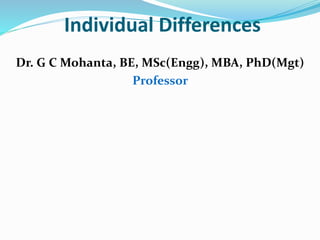
Individual differences
- 1. Individual Differences Dr. G C Mohanta, BE, MSc(Engg), MBA, PhD(Mgt) Professor
- 2. Individual Differences People show substantial individual differences, or variations in how they respond to the same situation based on personal characteristics. Behavior is a function of person interacting with the environment: B = f (P x E). Behavior is, therefore, determined by the effects of the individual and the environment on each other .
- 3. Importance of Individual Differences Importance of individual differences among employees are as follows: Individual differences have a direct effect on behavior People who perceive things differently behave differently People with different attitudes respond differently to directives People with different personalities interact differently with bosses, coworkers, subordinates, and customers Some people embrace change and others are fearful of it Some employees will be productive only if they are closely supervised, while others will be productive if they are not Some workers learn new tasks more effectively than others
- 4. Consequences of individual differences People differ in productivity. Quality of work varies because people vary in their propensity for achieving high-quality results. Empowerment is effective with some workers, but not with all. A given leadership style does not work with all people. People differ in their need for contact with other people. Company management will find that commitment to the firm varies considerably. Workers vary in their level of self-esteem that in turn influences their productivity and capacity to take on additional responsibility.
- 5. Individual Differences in Workplace Individual differences in hereditary and diversity factors, personality, ability and skills, perception and attitude will affect work behavior like productivity, creativity and performance. Demographic characteristics are the background characteristics that help shape what a person becomes. Important demographic characteristics for the workplace are gender, age, race, ethnicity and able- bodiedness.
- 6. Individual Differences in Workplace (Contd.) Gender There is no consistent differences between men and women in problem-solving abilities, analytical skills, competitive drive, motivation, learning ability and sociability. As compared to men, women are more conforming, have lower expectations of success, have higher absenteeism and lower earnings. Age Older workers are often stereotyped as inflexible. They sometimes complain that their experience and skills are not valued. They generally have lower turnover and lower avoidable absences.
- 7. Individual Differences in Workplace (Contd.) Able-bodiedness Despite evidence of effective job performance, most disabled persons are unemployed. Most disabled persons want to work and more firms are likely to hire disabled workers in the future. Racial and ethnic groups Differences in job performance and behavior of racial and ethnic groups are usually attributable to culture rather than ethnicity itself.
- 8. Individual Differences in Workplace (Contd.) Aptitude and Ability Aptitude is a person’s capability of learning something. Ability is a person’s existing capacity to perform the various mental or physical tasks needed for a given job. It includes relevant knowledge and skills. Intellectual Ability is the capacity to do mental activities. Intelligence contains four sub-parts: cognitive, social, emotional, and cultural.
- 9. Individual Differences in Workplace (Contd.) Groups of Mental abilities (L.L.Thurston) Verbal factor (V)-Comprehension of verbal relations, words & ideas. Spatial factor (S)-Involved in any task in which the subject manipulates an object imaginatively in space. It can also refer to how people perceive the object in front of them Numerical factor (N)-Ability to do numerical calculations rapidly and accurately. Memory factor (M)-Involves the ability to memorize quickly. Word fluency factor (W)-Involved whenever the subject is asked to think of isolated words at a rapid rate.
- 10. Individual Differences in Workplace (Contd.) Inductive reasoning factor (RI)-The ability to draw inferences or conclusions on the basis of specific instances. Deductive reasoning factor (RD) - is the ability to make use of generalized results. Perceptual factor (P) - is the ability to perceive objects accurately. Problem solving ability factor (PS) - is the ability to solve problem with independent efforts.
- 11. Individual Differences in Workplace (Contd.) Multiple Intelligences (Howard Gardner’s Work ) 1. Linguistic intelligence – good at using words well, both when writing and speaking. 2. Logical-mathematical intelligence - good at reasoning, recognizing patterns and logically analyzing problems. 3. Musical intelligence – good at music, musical composition and performance. 4. Bodily-kinesthetic intelligence - good at body movement, performing actions and physical control.
- 12. Individual Differences in Workplace (Contd.) 5. Spatial intelligence - good with directions, maps, charts, videos and pictures. 6. Interpersonal intelligence - good at understanding and interacting with other people. 7. Naturalist intelligence - more in tune with nature, interested in nurturing, exploring the environment and learning about other species. 8. Intrapersonal intelligence - good at being aware of their own emotional states, feelings and motivations.
- 13. Individual Differences in Workplace (Contd.) Physical Abilities - The capacity to do tasks demanding stamina, dexterity, strength, and similar characteristics. Nine Physical Abilities are: Strength factor Dynamic- Ability to exert muscle force repeatedly over time. Trunk- Ability to exert muscular strength using the trunk muscles. Static-Ability to exert force against external objects. Explosive-ability to exert a maximal amount of force in the shortest possible time interval.
- 14. Individual Differences in Workplace (Contd.) Flexibility factor External-Ability to move the trunk and back muscles as far as possible. Dynamic-Ability to make rapid, repeated flexing movements. Other factors Body coordination-Ability to coordinate the simultaneous actions of different parts of the body. Balance-Ability to maintain equilibrium despite forces pulling off balance. Stamina- Ability to continue maximum effort requiring prolonged efforts over time.
